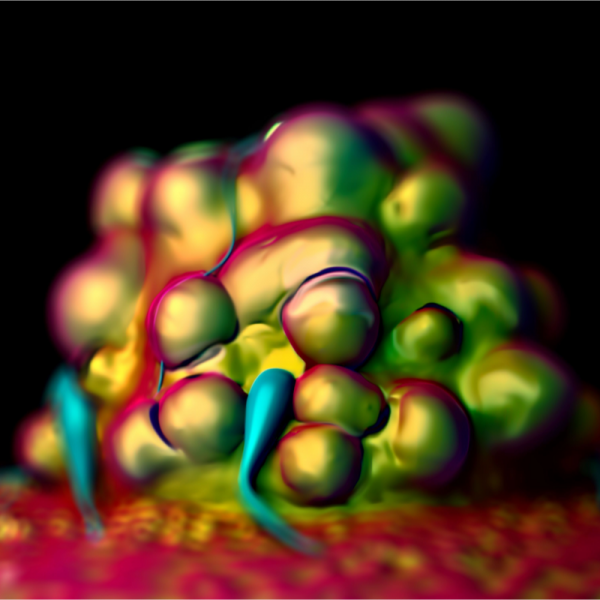
What are oligodendrogliomas?
An oligodendroglioma is a brain tumour (glial tumour) that mainly affects adults between 35 and 50 years of age. On average, oligodendrogliomas are slightly more common in men than in women. Overall, oligodendrogliomas probably make up about one percent of all gliomas, i.e. primary brain tumours. The World Health Organisation (WHO) divides oligodendrogliomas into four grades, which can cause different symptoms and according to which grade the possible courses of treatment differ. An oligodendroglioma requires rapid treatment and has different prognoses depending on its severity.
How does an oligodendroglioma develop?
Under the microscope, an oligodendroglioma resembles oligodendrocytes, which also originate in the brain and are the so-called supporting cells, the myelin sheaths. However, unlike oligodendrocytes, oligodendrogliomas do not form these myelin sheaths.
An oligodendroglioma usually develops in the cerebrum, specifically in the frontal lobe of the brain. However, in principle it is also possible for an oligodendroglioma to occur in other areas of the brain. However, the brain stem or the cerebellum are more rarely affected.
What are the different forms of oligodendroglioma?
The World Health Organisation (WHO) distinguishes between the following four grades of oligodendroglioma, which differ in their degrees of malignancy and growth:
- Grade I: benign oligodendroglioma, which grows only slowly and has very good prospects of cure,
- Grade II: Oligodendrogliomas with a high recurrence rate (recurrence), which may also become malignant,
- Grade III: Malignant oligodendroglioma, which is surgically removed and then treated with chemotherapy or radiotherapy,
- Grade IV: very malignant oligodendroglioma that grows quickly and requires radiation or chemotherapy after surgery.
What symptoms does an oligodendroglioma cause?
Only at a late stage can oligodendroglioma cause the following rather unspecific symptoms:
- Headaches, which can be accompanied by nausea and vomiting and indicate increased intracranial pressure,
- epileptic seizures and/or neurological deficits,
- Signs of a stroke, such as paralysis on one side, speech problems, etc., which can occur when the glioma bleeds into the brain.
Headaches caused by an oligodendroglioma, unlike normal headaches, occur very suddenly. Within just a few days or weeks, the headache can become increasingly severe and is almost impossible to treat, even with painkillers. People often report that the headache gets worse when they are lying down and goes away spontaneously when they are in an upright position.
In an even more advanced stage, so-called hydrocephalus symptoms can occur if the brain tumour disturbs the outflow of cerebrospinal fluid. If the following symptoms occur, they should be clarified by a doctor:
- Memory disorders,
- Fatigue and/or tiredness,
- Dizziness and/or nausea
How is an oligodendroglioma diagnosed?
The attending physician will first take the patient's medical history and, if necessary, describe his or her symptoms. The doctor can then narrow down the possible causes of the complaints and, if a brain tumour is suspected, carry out a neurological examination. During the neurological examination, which is carried out using imaging procedures such as a computer tomography (CT), the suspicion of a brain tumour is then confirmed by unusual tissue accumulations.
An even more precise determination of the brain tumour is possible through magnetic resonance imaging (MRI). Here, irregularities in the brain structures become visible. A biopsy can be performed by taking a tissue sample.
What are the possibilities for early detection?
The risk factors that can contribute to the development of an oligodendroglioma are still unknown to medical experts. Since neither an unhealthy diet nor genetic factors can be specifically used as risk factors, there are still no early detection programmes or corresponding measures with which the development of an oligodendroglioma can be prevented or detected at an early stage.
Since the symptoms of an oligodendroglioma are usually not only unspecific, but also appear late, the complaints should be clarified by a doctor right away. Only with the help of imaging procedures can a definite diagnosis be made and the appropriate treatment steps be initiated. As with other cancers, the earlier the tumour is diagnosed, the better the chances of cure.
How is oligodendroglioma treated?
The treatment of oligodendroglioma always depends on the degree of the tumour. A second-degree oligodendroglioma is usually removed surgically and then treated with radiotherapy and/or chemotherapy if there is a high risk of recurrence.
A third-degree oligodendroglioma is also usually removed surgically and then treated with chemotherapy. PCV or temozolomide are often used to prevent the tumour from growing again.
In addition to direct tumour treatment, rehabilitation is also an important part of the therapy. Especially for patients who have already undergone neurological changes, rehabilitation should lead to a better quality of life. This can be achieved, for example, through the following treatment options:
- targeted speech therapy (logopaedics), if speech deficits have occurred,
- Occupational and/or physiotherapy, if physical impairments have occurred,
- special computer programmes can be used for neurocognitive training.
Which specialist should be consulted for an oligodendroglioma?
Especially in the case of an oligodendroglioma, several specialists should work together because the tumour is often accompanied by numerous complaints. It is advisable for those affected to first consult a neurologist. The neurologist will not only perform the neurological tests, but also confirm the suspicion of the disease. In addition, the person concerned should consult a radio-oncologist, who should be consulted to determine the exact type of tumour. Oncologists, the so-called specialists for cancer diseases, as well as neurosurgeons can carry out further diagnostic examinations if necessary and enforce appropriate treatment methods.
